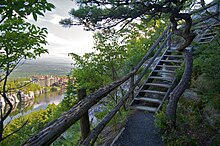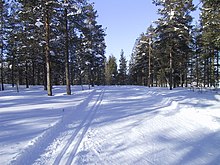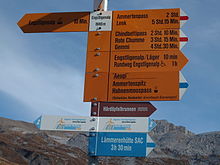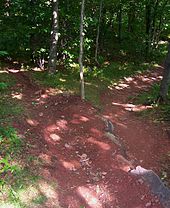User:Rudresh.ge



A trail (also track, byway, footpath, etc.) is normally a path with a rough beaten or dirt/stone surface used for travel. Trails may be for use only by walkers, but some are also be used for cycling, horse riding, snow shoeing, or cross-country skiing, and less often for moving cattle and other livestock. A trail can also be a marked route on a navigable waterway. In some places trails are the main access route to remote settlements.
Usage
[edit]
In modern use, the term "trail" often denotes "hiking trail".
Historically, the term was used for a route into or through wild territory used by emigrants (e.g. the Oregon Trail) in the USA. In the early years of the 20th century the term auto trail was used for a marked highway route, and trail is now also used to designate routes, including highway routes, designated for tourist interest (e.g. National Historic Trails, the Cabot Trail and Quilt Trail) in North America. The term trail has also been used by developers and urban planners for a variety of modern paved roads, highways, and boulevards, in North America. A particularly unusual use of the term is in the province of Alberta, Canada, which has multi-lane freeways called trails.
In Australia, the term track can be used interchangeably with trail, and can refer to anything from a dirt road to an unpaved pedestrian path. The term trail gained popularity during World War II, when many servicemen from the United States were stationed in Australia, which probably influenced its being adopted by elements of the Australian media at the time (see Kokoda Track).
In New Zealand, the terms track or walkway are used almost exclusively except in reference to cross-country skiing: "walkways vary enormously in nature, from short urban strolls, to moderate coastal locations, to challenging tramps [hikes] in the high country [mountains]".[1] Walkway is used similarly in St. John's, Newfoundland, Canada, where the "Grand Concourse", is an integrated walkway system.[2]
In the United Kingdom, the term trail is used, but mostly for longer distance walking routes through open country with rough surfacing. However, such trails are usually called a way, as in the Pennine Way, South Downs Way, etc. In England and Wales, the government-promoted, long distance paths are known collectively as National Trails. Generally the term footpath is preferred for pedestrian routes, but is used for urban paths and sometimes in place of pavement, as well as longer distance trails. Track is used for wider paths (wide enough for vehicles), often used for hiking. The terms bridleway, byway, restricted byway are all recognised legal terms and to a greater or lesser extent in general usage.
In the United States, the term trail is often used for a long-distance path not used by motor vehicles. The vehicles allowed on a trail vary depending upon the actual trail. However, some highways continue to be officially called a trail, such as the Susquehanna Trail in Pennsylvania, a designation that varies from a two-lane road to a four-lane freeway.
Trail types and use
[edit]Walking trails
[edit]
Trail use has become very popular for a wide variety of users. Some trails are designated as educational trails which are specially laid-out paths that offer information on specific natural, technological or cultural themes at various stations en route, usually by means of information boards and/or exhibits. One example is the nature trail, which is used by people learning about the natural world. Many trails are designated day trails, meaning that they are generally used by people out for a short hike, less than a day. Some trails are designated backpacking trails, or long-distance trails, and are used by both day hikers and by backpackers. Some of the trails are over one thousand miles (1,600 km) long and may be hiked in sections by backpackers, or completed in one trip by dedicated hikers. Some trails are specifically used by other outdoor enthusiasts to gain access to another feature, such as good climbing sites. Many runners also favor running on trails rather than pavement, as giving a more vigorous work-out and better developing agility skills, as well as providing a more pleasant exercise environment.
Stairway trails
[edit]

Stairway trails are another way to ascend higher slopes. The stairs are constructed by making cuts in the dirt, rocks, or concrete. Stairway trails are usually for walking only. Popular stairway trails include the Stairway Trails in Bernal Heights, East - San Francisco, and the stairs at many hilltop Hindu temples such as the Palani Murugan Temple located in Tirumala, used during pilgrimage & Machu Picchu.[citation needed]
Rail trails
[edit]Rail trails/paths are shared-use paths that make use of abandoned railway corridors. They can be used for walking, cycling and horse riding. They exist throughout the world and the following is a description of trails in Australia:
- Following the route of the railways, they cut through hills, under roads, over embankments and across gullies and creeks. Apart from being great places to walk, cycle or horse ride, rail trails are linear conservation corridors protecting native plants and animals. They often link remnant vegetation in farming areas and contain valuable flora and fauna habitat. Wineries and other attractions are near many trails as well as B&B's and other great places to stay.[3]
Most trails have a gravel or dirt surface suitable for walking, mountain bikes and horses. In the USA the 27 mile/43 km long Cheshire Rail Trail, in New Hampshire, can be used by hikers, horseback riders, snowmobilers, cross-country skiers, cyclists, or even a dogsledders.
In Canada, following the abandonment of the Prince Edward Island Railway in 1989, the government of Prince Edward Island purchased the right-of-way to the entire railway system. The Confederation Trail was developed as a tip-to-tip walking/cycling gravel rail trail which doubles as a monitored and groomed snowmobile trail during the winter months, operated by the PEI Snowmobile Association.
Bicycle trails
[edit]This article is about a type of path. For the geometric parameter of bicycles, see Bicycle and motorcycle geometry.
Bicycle trails or shared-use paths may be built to a different set of standards than pedestrian-only trails (hiking trails or sidewalks). In some cases, bicycle trails require a harder surface, fewer changes in grade and slope, increased sight visibility, and fewer sharp changes in direction. On the other hand, the cross-slope of a bike trail may be significantly greater than a foot trail, and the path may be narrower in some cases. The American Association of State Highway and Transportation Officials recommends different widths for different types of bicycle facilities.[4] For example, a shared use path has a recommended one directional width of 8 feet (2.44 m), while a bidirectional path should be significantly wider (10 to 12 feet or 3.05 to 3.66 metres) to accommodate bidirectional traffic and users. The U.S. Department of Transportation provides additional guidance on recreational bicycle and pedestrian trail planning and design standards.[5]


Downhill mountain biking can cause soil erosion and habitat destruction, if not carried out on established trails. Downhilling is particularly popular at ski resorts such as Mammoth Mountain in California or Whistler Blackcomb in British Columbia, where ski lifts are used to get bikes and riders to the top of the mountain.
Because bicycles require less steep grades than hikers, bike trails may have multiple switchbacks, while these may not be necessary for hikers. In cases where hikers use these bike trails, they may be tempted to cut the switchbacks.[citation needed]
Where bike trails intersect with pedestrian or equestrian trails, signage at the intersections and high visibility onto the intersecting trails are needed in order to prevent collisions between fast-moving cyclists and slower moving hikers and horses. Bicycles and horses can share the same trails where the trail is wide enough with good visibility. The U.S. Department of Transportation provides standards and guidelines for traffic control, including signage and striping, for bicycle facilities.[7]
A well designed recreational bike off road bicycle path (trail) for the exclusive use of bicycles has an average grade of less than 10%, and generally follow a contour line, rather than straight downhill. Bicycle trails slope out or across the trail 3-5% downhill to encourage water to run off the side, rather than down the trail bed. In addition, frequent grade reversals prevent water from running down the trail, make the trail more fun and interesting to ride, and generally help keep bike speeds down, providing a more safe trail experience for all users.[citation needed]
Equestrian trails
[edit]
Horse riding and other equestrian uses of trails continue to be a popular activity for many trail users.[8] Horses can negotiate much steeper terrain on a dirt trail, for instance, than on a gravel trail.[citation needed] Horses can usually negotiate much the same grades as hikers, but not always, although they can more easily clear obstacles in the path such as logs.[9]
The Bicentennial National Trail (BNT) in Australia is the longest marked multi-use trail in the world, stretching 5,330 kilometres from Cooktown, Queensland, through New South Wales to Healesville, Victoria. This trail runs the length of the rugged Great Dividing Range through national parks, private property and alongside of wilderness areas. One of the objectives was to develop a trail that linked up the brumby tracks,[8] mustering and stock routes along the Great Dividing Range, thus providing an opportunity to legally ride the routes of stockmen and drovers who once travelled these areas with pack horses. This Trail provides access to some of the wildest, most remote country in the world.[8] The Bicentennial National Trail is suitable for self-reliant horse riders, fit walkers and mountain bike riders.[9]
Within the United States National Trail Classification System,[10] equestrian trails include simple day-use bridle paths and others built to accommodate long strings of pack animals on journeys lasting many days. Trail design parameters for these uses include trail base width and material, trail clear width, trail clear height, access to water suitable for stock (not human) use, and trail routing.
Cross-country skiing trails
[edit]
In cross-country skiing a trail is also called a track or piste.[11] Recreational cross-country skiing is also called touring, especially in Europe. Some skiers stay out for extended periods using tents and equipment similar to bushwalkers and hikers, whereas others take relatively short trips from ski resorts on maintained trails. In some countries, organizations maintain a network of huts for use by cross-country skiers in wintertime. For example, the Norwegian Mountain Touring Association maintains over 400 huts stretching across hundreds of kilometres of trails which are used by hikers in the summer and by skiers in the winter.
Water trails
[edit]Water trails (also referred to as Blueways or Paddling Trails) are marked routes on navigable waterways such as rivers, lakes, canals and coastlines for people using small non-motorized boats such as kayaks, canoes, rafts, or rowboats. Some trails may be suitable for float tubing or developed in concert with motorized use. They include: signs and route markers; maps; facilities for parking, boat ramps or docks, and places to camp and picnic. There are also state programs and other promotion for water trails.[12][13]
The American Canoe Association has compiled a database of water trails in the United States.[14]
The National Park Service Rivers, Trails, and Conservation Assistance Program has compiled a list of water trail resources, success stories, and statewide contacts for water trails. [15]
Motorized trails
[edit]
Motorized trail use also remains very popular with some people. Such terms as ORV, four-wheeling, all-terrain vehicle, and others actually have highly specific meanings. In the United States, this group of people have a very strong political lobby. The Recreational Trails Program defined as part of the Intermodal Surface Transportation Efficiency Act (ISTEA, /ˌaɪsˈtiː/) of 1991 mandates that states must use a minimum of 30 percent of these funds for motorized trail uses.
Urban and suburban trails
[edit]Urban pedestrian footpaths or trails are sometimes called alleys or lanes and in older cities and towns in Europe are often what is left of a medieval street network or right of ways or ancient footpaths. Similar paths also exist in some of the older North American towns and cities, like Charleston, South Carolina, New Castle, Delaware, and Pittsburgh, Pennsylvania. Such urban trails or footpaths are narrow, usually paved and often between the walls of buildings. This type is usually short and straight, and on steep ground can consist partially or entirely of steps. Some are named. Because of geography steps (stairs) are the predominant form of footpath in hilly cities and towns. This includes Pittsburg (see Steps of Pittsburgh), Cincinnati (see Steps of Cincinnati), Seattle,[16] and San Franscisco[17] in the United States, as well as Hong Kong,[18] Quebec City, Quebec, Canada,[19] and Rome.[20]

In Northern America, where urban sprawl has begun to strike even the most rural communities, developers and local leaders are currently striving to make their communities more conducive to non-motorized transportation through the use of less traditional trails. The Robert Wood Johnson Foundation has established the Active Living by Design program to improve the livability of communities in part through the trails, both in a more traditional sense, as is being done by the Upper Valley Trails Alliance or in the broader, as is being done by Groundwork Somerville. In St. John's, Newfoundland, Canada the "Grand Concourse", is an integrated walkway system that has over 160 kilometers (99 mi) of walkways, which link every major park, river, pond, and green space in six municipalities.[2]
Several long distance walking trails have been established within the boundaries of London, England, including the Capital Ring a 75 miles (121 km) circular route with 15 sections and a radius of approximately 4–8 miles (6–13 km) from Charing Cross, in the centre of London, mostly through the inner Outer London suburbs and partly in Inner London. The route forms a complete circuit, crossing the River Thames twice and makes use of existing rights of way, parks and other open spaces, as well as some regular suburban streets. The Thames Path, National Trail runs through the centre of London. This has been established through the active creation of new rights to way by local government.[21]
Another type of trail that was quite popular in the 1970s and 1980s but is less popular today is the exercise trail (also known as trim trail), which combines running with exercise stations.
Trail difficulty ratings
[edit]A simple colored symbol to classify a trail's difficulty in the USA was first used for ski trails and is now being used for hiking, bicycle, other trails and even airport security lines.[22][23]
- Green circle - easy
- Blue square - moderate
- Black diamond - difficult
Other systems may be used in different locations.[24][25]
In Switzerland paths are classified by three levels of difficulties: Hiking paths (yellow markers), mountain paths (white-red-white markers) and alpine paths (white-blue-white markers).

mountain path in white-red-white,
Alpine Route in white-blue-white
Segregation
[edit]Trail segregation, the practice of designating certain trails as having a specific preferred or exclusive use, is increasingly common and diverse. For example, segregated cycle facilities, for bicycles, are used not only on roads open to motor vehicles, but also in trail systems open to other trail users. Some trails are segregated for use by both equestrians and mountain bikes, or by equestrians only, or by mountain bikes only. Designated "wilderness area" trails may be segregated for non-wheeled use (hence permit backpacking and horses but exclude mountain bikes and motorized vehicles).
Often, trail segregation for a particular use is accompanied by prohibitions against that use on other trails within the trail system.
Trail segregation may be supported by signage, markings, trail design and construction (especially selection of tread materials), and by separation between parallel treads. Separation may be achieved by "natural" barriers including distance, ditching, banking, grading, and vegetation, and by "artificial" barriers including fencing, curbing, and walls.
The opposite of segregated use is shared use. Shared use may be achieved by sharing a trail easement, but within it maintaining segregated and sometimes also separated trail treads. This is common in rail trails. Shared use may also refer to alternate day arrangements, whereby two uses are segregated by being permitted on alternate days. This is increasingly common in long-distance trails shared by equestrians and mountain bike users; these two user communities have similar trail requirements but may experience encounters with each other on the trail as difficult.
Trail administration
[edit]This section needs expansion. You can help by adding to it. (January 2007) |
In 1968, the United States created its National Trails System, which includes National Scenic Trails, National Historic Trails and National Recreation Trails.
The rules and regulations for a trail are written and enforced by the land management agency in charge of the trail. A trail may be completely contained within one administration (e.g. a State Park) or it may pass through multiple administrations, leading to a confusing array of regulations, allowing dogs or mountain bikes in one segment but not in another, or requiring Wilderness Permits for a portion of the trail, but not everywhere.
In the United States agencies administering trails include the National Park Service, the U.S. Forest Service, the Bureau of Land Management, State Park systems, County Parks, cities, private organizations such as land trusts, businesses and individual property owners.
New trail construction by an agency must often be assessed for its environmental impact and conformance with State or Federal laws. For example, in California new trails must undergo reviews specified by the California Environmental Quality Act (CEQA).[26]
In the United Kingdom many trails and footpaths are of ancient origin and are protected under law as rights of way. In Ireland, the Keep Ireland Open[27] organization is campaigning for similar rights.
Trail construction
[edit]
While many trails have arisen through common usage, quality trail design and construction is a complex process requiring certain sets of skills.
When a trail passes across a flat area that is not wet, often all that is required is to clear brush, tree limbs and undergrowth to produce a clear, walkable trail. When crossing streams, bridges may or may not be desirable, depending on the size of the stream and the depth of its banks. In wet areas, it may be necessary to create an elevated trailway with fill or by building a boardwalk. One problem with boardwalks is that they require frequent maintenance and replacement - boards in poor condition are often slippery and hazardous.
Trails on slopes
[edit]A common mistake in establishing trails is to make them on slopes that are too steep for comfort and the environment. Such steep trails generally result in serious erosion, a wide swath of impacted area as walkers go to the sides to find better footing, and the inability of many hikers to walk the trail. Trail gradient should be determined based on a site specific assessment of soils & geology, drainage patterns of the slope, surrounding vegetation types, position on the slope of a given trail segment (bottom, mid-slope, ridgeline), average precipitation, storm intensities, types of use, volume & intensity of use, and a host of other factors affecting the ability of the trail substrate to resist erosion and provide a navigable surface. Trails that ascend steep slopes may use switchbacks, but switchback design and construction is a specialized topic that takes great care.
If a trail is being made to be accessible to off-road wheelchairs, the grade should be no more than one in ten. If a paved trail has to be accessible to all wheelchairs, the grade must be no more than one in twelve, with periodic level pull-offs.
The off-slope, or side-slope, of the trail also must be considered. This is the slope of the trail from side to side, and should never be more than one in twelve. Side-sloped trails are prone to gullying. Ideally, the treadway of the trail should be almost, but not quite, level in cross-section.
Achieving the proper slope in hilly terrain usually requires the excavation of sidehill trail. This is trailway that is constructed by establishing a line of suitable slope across a hillside, then digging out by means of a mattock or similar tool to create the trail. This may be a full-bench trail, where the treadway is only on the firm ground surface after the overlying soil is removed and sidecast (thrown to the side as waste), or a half-bench trail, where soil is removed and packed to the side so that the treadway is half on firm old ground and half on new packed fill. In areas near drainages, creeks and other waterways, excavation spoils should be end-hauled (taken away in bulk and deposited in an environmentally benign area). In problem areas, it may be necessary to establish the trail entirely on fill. In cases where filling is used, it's necessary to pack it firmly and to revisit the site periodically to add to the fill and repack it until fully stable.
Drainage
[edit]
A critically important and often-overlooked factor in trail construction is that of drainage. There are three general types of drainage problems on trails. The first is accumulation of water to the point that the trail is unusable. The second is erosion from moving water on the trail. The third is the creation of local mud spots.
The first type of drainage problem is common in places such as the north country. In such places, it is often necessary to build some type of raised walkway. This is often done by cutting poles from the woods, staking parallel poles in place on the ground, then filling between them with whatever material is available to create the raised walkway. The more elaborate option of the deckwalk is by necessity reserved for shorter stretches in very high-traffic areas.
The second type of problem is caused because trails, by their nature, tend to become drainage channels and eventually gullies if the drainage is not properly controlled. Where a trail is near the top of a hill or ridge, this is usually a minor issue, but when it is farther down it can become a very major issue.
In areas of heavy water flow along a trail, it may be necessary to create a ditch on the uphill side of the trail with drainage points across the trail. The cross-drainage may be accomplished by means of culverts, which must be cleared on a semi-annual basis, or by means of cross-channels, often created by placing logs or timbers across the trail in a downhill direction, called "thank-you-marms", "deadmen", or waterbars. Using timbers or rocks for this purpose also creates erosion barriers. Rock paving in the bottom of these channels and in the trailside ditches may help to maintain stability of these. Ideally, waterbars should be created, with or without ditching, at major points of water flow on or along the trail, and in conjunction, if possible, with existing drainage channels below the trail. Another important technique is to create coweeta dips, or drain dips, points on the trail where it falls briefly (for a meter or so) and then rises again. These provide positive drainage points that are almost never clogged by debris.
The third type of problem can occur both on bottomlands and on ridgetops and a variety of other spots. A local spot or short stretch of the trail may be chronically wet. If the trail is not directly on rock, then a mud pit forms. Trail users go to the side of the trail to avoid the mud pit, and the trail becomes widened, sometimes bizarrely so. If the drainage can be corrected, it must be. A common option if the location cannot be effectively drained is the "corduroy." This can range from random sticks laid across the path to split logs being laid across the path. Some of the early turnpikes in the United States were log corduroys, and these can still be found in third-world forested areas. With recreational trails, it is common to cut sticks that may be one to three inches thick and lay them in place, as close together as can be achieved. Sometimes, a short bridge may be a more feasible option.
Water crossings
[edit]For pedestrian use, footbridges may be preferred. Other options are culverts, stepping stones, and shallow fords. For equestrian use, shallow fords may be preferred.
Trail width
[edit]Trail width has two main components: width of the trail base or footbed; and width of the clear space on either side of the trail, as in cuts on steep slopes, tunnels, and through vegetation. Variants in width include single track and two track trails.
Multi-use trails
[edit]
Trails intended for use by bicycles, wheelchairs, equestrians, and pedestrians will often be surfaced, especially in heavily-used or urban areas. A wide variety of surface materials are used, including asphalt paving and compressed dust such as: crushed rock fines, cinders, or decomposed granite. Such trails will also have well-built bridges with a supported deck and side rails.
There has been a major effort to convert abandoned railroad grades to bike paths or multi-use paths. This has been termed "rails-to-trails". Railroads in use with adjacent trails are rails with trails.
Signage
[edit]
For long-distance trails, or trails where there is any possibility of anyone taking a wrong turn, blazing or signage is provided (the term way mark is used in Britain). This is accomplished by using either paint on natural surfaces or by placing pre-made medallions. Horseshoe-shaped blazes are frequently used for bridle trails. The Appalachian Trail is blazed with white rectangles. Blue is often used for side trails. European long distance walking paths are blazed with yellow points encircled with red. However, other walking paths in European countries are blazed in a variety of manners.
Trail Naming
[edit]Trails are given names to assist with communicating to others and for cateloging. Names often reflect the expectations of sights the trail user will see along the trail. In the case of trail systems, trail names may take on a theme. Trail names also help with navigation and location, especially for emergencies. Ski trail (aka Piste) networks that criss-cross a mountainside will often change names at intersections such that emergency services like Search and rescue or Ski Patrol can communicate more precisely about where they are and where they are going.
Maintenance
[edit]Natural surface, single track trails will require some ongoing maintenance. However, if the trail is properly designed and constructed, maintenance should be limited to clearing downed trees, trimming back brush and clearing drainages. Depending on location, if the trail is properly designed, there should be no need for major rework such as grading or erosion control efforts. However, mountain trails which see both significant rainfall and human traffic may require "trail hardening" efforts in order to prevent further erosion. Most of the seemingly natural rock steps on the mountain trails of the northeast United States are, in fact, the work of professional and volunteer trail crews.
See also
[edit]- Alley
- Bicentennial National Trail
- Boardwalk
- Bridleway
- Cavalcade
- Corpse road
- Desire path
- Drovers road
- Educational trail
- Footpath
- Great Baikal Trail
- Inca trail to Machu Picchu
- Israel National Trail
- Jeep trail
- Kokoda Track
- Long-distance trail
- Milford Track
- Natural lines of drift
- New Zealand Great Walks
- Rail trail (former railway)
- Rights of way in England and Wales
- Rights of way in Scotland
- Segregated cycle facilities
- Themed trail
- Towpath (on a canal)
- Water gap
- Water trail
- Wind gap (geographical feature)
References
[edit]- ^ Government of New Zealand
- ^ a b Grand Concourse Authority: [1].
- ^ Railtrails Australis: <>
- ^ "Guide for the development of bicycle facilities" (PDF). American Association of State Highway and Transportation Officials. 1999.
- ^ "Manuals and Guides for Trail Design, Construction, Maintenance, and Operation, and for Signs". US Federal Highway Administration.
- ^ "ON THE TOWNS". The New York Times. August 4, 1996. Retrieved 2012-07-24.
- ^ "The Manual on Uniformed Traffic Control Devices (MUTCD)". 2009.
{{cite web}}:|chapter=ignored (help) - ^ a b c The Bicentennial National Trail, Welcome to One of the World's Great Natural Adventures
- ^ a b BNT
- ^ National Trail Classification System, FSM 2350, and FSH 2309.18, Federal Register: July 3, 2006 (Volume 71, Number 127), Pages 38021-38052 online copy on epa.gov
- ^ "piste" New Oxford American Dictionary
- ^ http://www.americantrails.org/resources/water/
- ^ http://www.americantrails.org/resources/water/National-Water-Trails-overview.html
- ^ ACA website
- ^ NPS Water Trails website
- ^ "Steps of Seattle" on the Seattle Staiways website
- ^ "Stairways" on the Sister Betty website
- ^ Alliance For a Beautiful Hong Kong: [2].
- ^ Collins, Ross. "Quebec: a poor man's Europe" The Forum (October 1992)
- ^ "5 Steps to Rome" on the Italian Notes website.
- ^ London Assembly, "Access to the Thames"
- ^ John Fry (November 2008). "Signs of the Times". SKI Magazine. Retrieved 2011-08-25.
- ^ "Trails/Hiking: Explanation of Trail Difficulty". US Forest Service. Retrieved 2011-08-25.
- ^ Trail Difficulty Classification. Trail Studies Unit, Trent University. Retrieved 2009-08-25.
- ^ Ski trail difficulty classifications. gavmck, Everything2, June 4, 2004. Retrieved 2009-08-25.
- ^ "CEQA". Retrieved 2012-04-04.
- ^ "Keep Ireland Open". Retrieved 2012-04-04.
